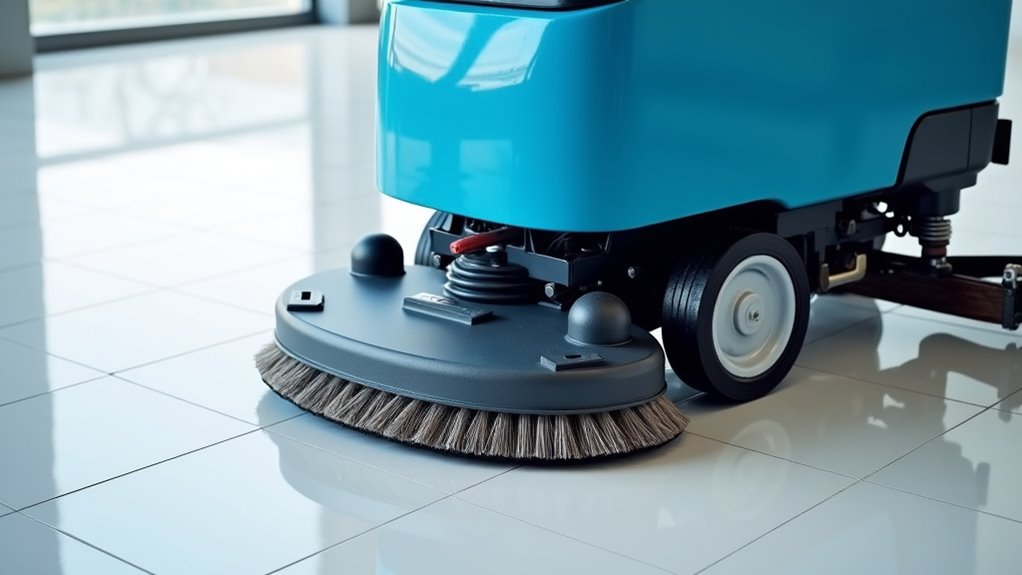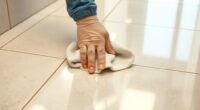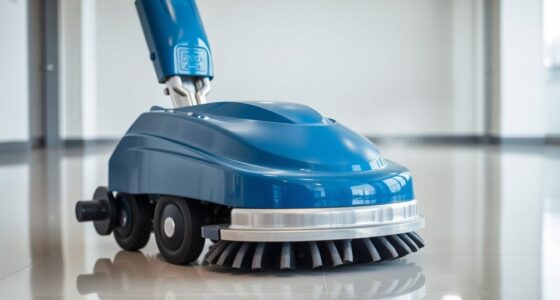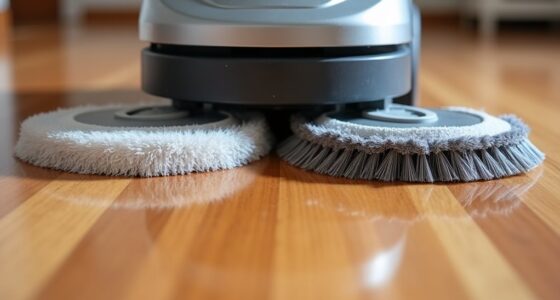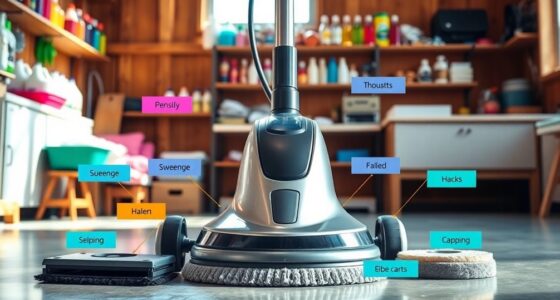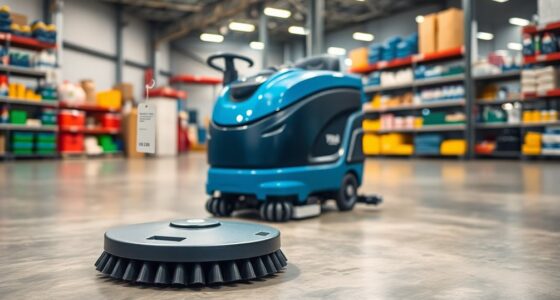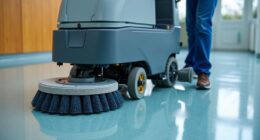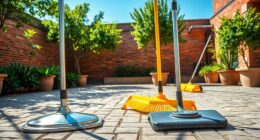When setting up your auto-scrubber for tile floors, choose between pads and brushes based on your cleaning needs. Pads are softer and ideal for delicate surfaces or light cleaning, helping preserve tile and grout. Brushes are more aggressive, suitable for stubborn grime and heavily soiled areas, providing deep scrubbing action. Ensuring proper attachment and compatibility is key for safety and performance. Keep learning to master the best setup for sparkling, well-maintained tiles.
Key Takeaways
- Choose pads for delicate tiles and light cleaning, and brushes for heavy grime or textured surfaces.
- Ensure proper attachment and compatibility of pads or brushes with your specific auto-scrubber model.
- Regularly inspect and clean tools after use to prevent debris buildup and maintain effectiveness.
- Verify batteries are fully charged and well-maintained for consistent operation during tile cleaning.
- Follow safety and maintenance routines to ensure optimal performance and prolong equipment lifespan.

Setting up your auto-scrubber for tile floors is straightforward, but proper preparation guarantees ideal cleaning results. Before diving into the cleaning process, you need to contemplate the type of scrubbing tool—pad or brush—that best suits your specific needs. Both options have their advantages, but understanding their differences can help you get the most out of your equipment. Additionally, paying attention to battery life is essential, especially if your auto-scrubber runs on rechargeable batteries. Ensuring your batteries are fully charged and well-maintained will maximize runtime and efficiency, reducing the chances of interruptions during cleaning sessions. Incorporate regular maintenance tips to extend battery life and keep your machine running smoothly, such as cleaning battery contacts and avoiding complete discharges. Proper maintenance is critical for preserving the longevity and performance of your cleaning equipment.
With your auto-scrubber ready, you’ll want to choose between a pad or brush based on your tile floor condition. Pads, typically made of softer materials, are ideal for delicate surfaces or light cleaning tasks. They provide a gentle yet effective scrub, helping to preserve the integrity of your tiles and grout. On the other hand, brushes—usually more aggressive—are better suited for heavily soiled floors or stubborn grime. They can dislodge dirt embedded deep within grout lines or textured tiles, ensuring a thorough clean. When setting up, attach the appropriate cleaning tool securely, making sure it’s compatible with your model. Proper attachment prevents slips or mishaps, ensuring safety and efficiency during operation.
As you prepare for cleaning, ponder the maintenance tips that will keep your equipment in peak condition. Regularly inspect your pads and brushes for signs of wear, replacing them when necessary to maintain cleaning effectiveness. Keep your auto-scrubber’s brushes and pads clean after each use, removing debris that can cause damage or reduce performance. Also, check the battery connections and charge levels before starting, especially if you notice a drop in runtime or power. Properly storing your auto-scrubber when not in use is equally important; store batteries in a cool, dry place and avoid exposing them to extreme temperatures to prolong their lifespan.
Frequently Asked Questions
Which Setup Is More Cost-Effective Long-Term?
Think of your auto-scrubber as a wise gardener choosing tools. A pad setup often proves more cost-effective long-term, thanks to lower initial costs and easier maintenance. When comparing the cost comparison and maintenance costs, it’s clear that pads require less frequent replacement and upkeep, saving you money over time. You’ll find that investing in the right setup keeps your floors shining without draining your budget.
How Often Should I Replace Pads or Brushes?
You should replace pads or brushes every 50 to 100 hours of use, depending on wear. Regular maintenance tips include checking for signs of damage or worn bristles, and cleaning the components after each use to extend their lifespan. Keep an eye on performance; if cleaning becomes less effective, it’s time for replacement. Properly maintaining and replacing your pads or brushes ensures maximum cleaning and cost-efficiency over time.
Can I Switch Between Pad and Brush During Cleaning?
Yes, you can switch between pads and brushes during cleaning, but first, check your auto-scrubber’s maintenance tips and compatibility concerns. Make sure the attachments fit properly and won’t damage your machine or floor. Switching can help tackle different dirt types or surfaces, but do it carefully to avoid unnecessary wear. Always turn off the machine before changing attachments and inspect them regularly for wear or damage.
Is There a Difference in Noise Levels?
Switching between a pad and a brush is like changing gears in a car—you’ll notice some noise difference. Typically, brushes produce louder sounds compared to pads, affecting noise comparison. This can influence setup efficiency, especially in noise-sensitive environments. If quiet operation matters most, using pads might be better. So, choose your setup based on your noise preference and cleaning needs to optimize performance and comfort.
Are Certain Setups Better for Delicate Tile Surfaces?
Yes, certain setups are better for delicate surfaces. For delicate tiles, using a soft pad or gentle brush minimizes abrasion and prevents damage. Opt for a cleaning method that prioritizes gentle agitation and avoids harsh scrubbing. You should select a setup that balances effective cleaning with surface safety, ensuring your delicate tiles stay intact and shiny. Always test a small area first to confirm the chosen setup works well without harming your surface.
Conclusion
Choosing between a pad and a brush for your auto-scrubber is like picking the right tool for a masterpiece. Each option has its own rhythm, its own dance with your tile floors. When you match the tool to your specific needs, cleaning becomes a smooth waltz rather than a tangled mess. So, pick your partner wisely, and let your floors shine like stars in a clear night sky—clean, bright, and effortlessly stunning.
